Sometime before 361 BCE, Polyeuktos, a busy Athenian from the deme of Teithras, arranged the divorce of his daughter Kleiokrateia from her first husband and then married her off to another, a man named Spoudias. The union was intended to put an end to some family unpleasantness and to secure a legal line of inheritance. In order to affirm and publicize the new state of affairs Polyeuktos (or his daughter and new son-in-law) commissioned two sculptors to create roughly life-size bronze statues of the newlyweds to dedicate to Demeter and Kore (Persephone), probably in the sanctuary known as the Eleusinion on the north slope of the Acropolis. The statues stood atop an unusual L-shaped marble base [Pl. XII] whose face was inscribed with several different kinds of texts [Fig. 52]. At the top was the dedicatory heading DĒMĒTRI KAI KOREI (To Demeter and Kore). Below that, on the left (and badly shattered) side, there were a few lines about Spoudias and, just below them, a (now fragmentary) signature:…YS[I]KL[ĒS EPOIĒSEN] ([Someone Whose Name Ended in]…ysikles made [me]). On the right side, a well-preserved text in five short lines tells us that Kleiokrateia was the daughter of Polyeuktos and the wife of Spoudias and then, in a sixth line, that PRAXITELĒS EPOIĒSEN (Praxiteles made [me, her statue]). It is likely that the two sculptors worked independently on their assigned portraits. Each one must have known what the other was making, and in that sense they collaborated on the monument. But so far as we know they were not in any real sense partners or members of a team. That was too bad for […]ysikles, because we hear (very likely) nothing more about him.
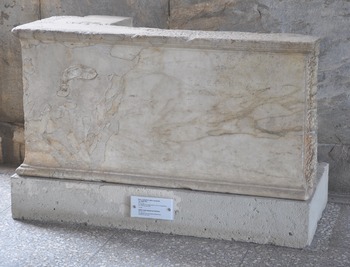
XII. Base of lost portrait statues of Spoudias and Kleiokrateia, signed by…ysikles and Praxiteles, before 361 BCE. Agora Museum I 4165.

52. Drawing of inscribed base of portrait statues of Spoudias and Kleiokrateia, signed by…ysikles and Praxiteles, before 361 BCE. Agora Museum I 4165.
But about Praxiteles we hear a lot. He would become one of the greatest (and richest) sculptors of the Late Classical period – his career is variously placed between 375 and 320 BCE – and some years after making Kleiokrateia's portrait he would create one of the most famous and influential statues of the ancient world: the nude (and for that reason revolutionary) Aphrodite of Knidos, usually dated to the 340s. But that was still to come. Here, on the monument to Demeter and Kore, his signature is perfectly centered just 4 centimeters below the Kleiokrateia text [Fig. 52]. But it is much more lightly cut, and it is minuscule by comparison [Fig. 53]: its letters are only 0.9 centimeters high, less than half the height of the more deeply cut letters in the lines about Kleiokrateia (2.1 centimeters), and those letters, in turn, are even larger, surprisingly, than the letters in the dedication to the goddesses at the top (1.9 centimeters).1 So, if font size is a guide to relative importance – if typography reflects a hierarchy among dedicant, honorand, and artist (an assumption that shall be tested later) – then the names of Kleiokrateia and Spoudias mattered even more than those of the divine Demeter and Kore. Praxiteles’ tiny, harder-to-read name mattered, too: otherwise it would not be there in the first place. But at this point in the early 4th century, near the beginning of his career, it may not have mattered all that much.2
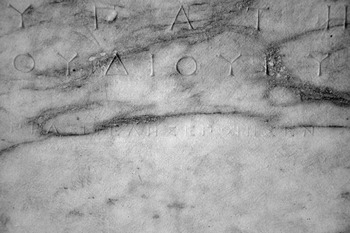
53. Praxiteles’ signature on Spoudias and Kleiokrateia base.
Near the end of his career (perhaps as late as the 320s) Praxiteles was commissioned by an Athenian woman named Arkhippe to create a portrait of her daughter, also named Arkhippe, to stand (once again) in the Eleusinion. Once again the statue does not survive (it was probably bronze), but its inscribed marble base does [Fig. 54]. And this time PRAXITELĒS EPOĒSEN is far more prominent. The signature is as deeply cut as the text about the mother dedicating the statue of her daughter. Like the dedication, it extends across the full width of the stone. Its letters are nearly as high (1.5 to 1.8 centimeters). And, importantly, it is inscribed 12 or 13 centimeters below the dedication. The center of the stone is actually left blank, and so the dedication above the emptiness and the signature below it each attract and merit the attention of the viewer on its own terms. In short, the gap between dedication and signature is a significant distance: it is a separation that creates a balance of emphasis between them.3 On the earlier Kleiokrateia base [Fig. 52], the proximity of the shallow, puny signature to the more impressive text just above places the artist in an obviously minor and subsidiary position – his contribution to the monument almost seems an afterthought. This, in contrast, appears to be the signature of an artist who had grown considerably in stature.4
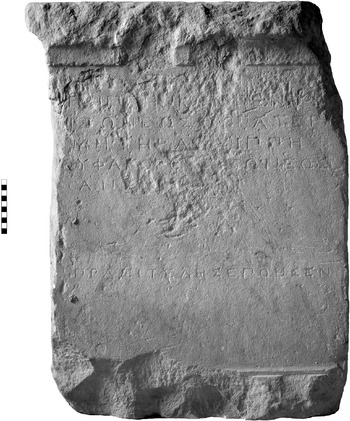
54. Base of portrait statue of Arkhippe, signed by Praxiteles; 320s BCE (?). Agora Museum I 4568.
Still, it needs emphasizing that Praxiteles did not inscribe the signature himself: it was cut by a professional letterer whose “hand” may be detected in a number of public decrees and records from the end of the 4th century. Praxiteles’ signatures on the Kleiokrateia and Arkhippe monuments [Figs. 53, 54] are thus proxy signatures, and proxies had been, in fact, the norm (if not the inviolable rule) in Greek sculpture since the late 6th century.5 Now, like any sculptor concerned about the final presentation of his work, Praxiteles almost certainly supervised the installation of his statues upon their bases and may have even overseen the layout and carving of their texts beforehand.6 But no matter what reputation he enjoyed, and whatever the degree of his involvement in the inscribing and installation of the monuments, the content and composition of the inscriptions on both bases were ultimately not under his control: they were up to the dedicants, the ones who paid the bills, the ones who had the discernment to hire Praxiteles in the first place and who must have benefited in some way from having his signature written upon the stones.
Most Greek free-standing statues in marble or bronze were dedications in sanctuaries or markers over tombs, and that is also true for nonarchitectural marble reliefs. Both statues and stelai were thus typically and predictably accompanied by texts written upon them or their bases – texts naming the dedicator and honorand (and sometimes the reason for the offering), texts naming the deceased (and sometimes the circumstances of death), texts that were meant to be read aloud (though, of course, in a crowded sanctuary or cemetery many might not be noticed). Naming was the purpose of these texts, and the voiced repetition of names part of their perpetuating power. Near the beginning of Archaic sculpture, for example, a bronze warrior (if he brandished a spear) or Apollo (if he held a bow) had the dactylic hexameter inscription
written boustrophēdon across his legs.7 Perhaps the earliest life-size Greek marble statue has
carved into the left side of her peplos.8 And the quintessentially Archaic kouros from Anavyssos [Fig. 2] stood atop a base inscribed with a poignant call to mourning in four lines:
Texts are often much more laconic than these. The base of a late kouros from the Mesogeia in eastern Attica, for example, is inscribed simply with one word, a name in the genitive: ARISTODIKO ([Marker] of Aristodikos).10
But whether the work was votive or funerary, whether the words were many or few, the Greek statue or stele was invariably part of an ensemble of text and image, and on occasion the ensemble included the signature of the sculptor. The best example extant may be the grave monument of Phrasikleia, an aristocratic girl who died around 550 BCE before she could marry and who was buried in a cemetery at Myrrhinous (Merenda) in rural eastern Attica [Fig. 55]. The well-preserved, elegantly attired, and once colorfully painted korē that marked her grave (discovered in 1972) stood atop a base that has been known since 1730. Its front face is poetically inscribed, stoikhēdon (that is, with the letters aligned vertically in columns and horizontally in lines):
And around the corner, at the top of the left side of the base (left as you face the statue, Phrasikleia's proper right), there is the signature ARISTION PARI[OS M'EP]O[E]SE [Fig. 56].11 There is not much room below the epitaph for a signature, but in fact Aristion of Paros, to judge from other works (such as his funerary monuments for Antilochos and Xenophantes), seems to have preferred to sign on the side of statue bases rather than on their front.12 At all events, the sēma of Phrasikleia is a rare example of a complete ensemble: statue, base, and texts (epitaph and signature) are all there.

55. The Phrasikleia korē, signed by Aristion of Paros; c. 550. Athens, National Museum 4889.
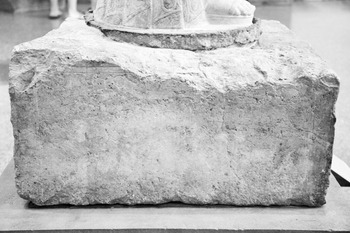
56. The signature of Aristion of Paros on the left side of the base of the Phrasikleia korē.
We are unlucky in the very small number of such ensembles that have survived intact: even the funerary monument of Kroisos [Fig. 2] – clearly the work of a major sculptor – is incomplete, lacking two of the three steps upon which the statue originally stood (a signature, for all we know, might have been inscribed upon one of them).13 Typically, we just have statues without bases and bases without statues. We have no ancient blocks (with or without inscriptions) on which to set the Riace Bronzes or the Artemision Bronze God or the marble Charioteer from Motya. And even at Delphi, where we have part of the inscribed base upon which the famous bronze Charioteer and his team of four once stood, there is no signature.14 On the other hand, we have a number of bases signed by Praxiteles [Pl. XII, Figs. 53, 54] and Lysippos [Fig. 57], but no Praxitelean or Lysippan originals to set upon them. In short, it is not often that we can pair an extant statue with an extant, signed base.
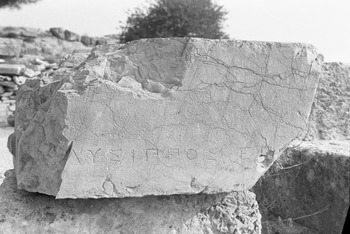
57. Statue base signed by Lysippos. Corinth I 29.
As it is, the Greek sculptor's signature, like that of any other Greek artisan, seems a random thing. We know the names of more than seven hundred Greek sculptors who worked before the Roman Empire (and more than two hundred more who worked during it), and this is roughly five times the number of wall- or panel-painters or ceramicists (potters, vase-painters) whose names we know.15 Still, the overwhelming majority of extant Greek statues, reliefs, and bases (even those with extensive dedications or epitaphs) lack signatures, and a few rough statistical samplings indicate just how meager the evidence is:
Sample 1. There are about three hundred extant works of Archaic sculpture from Attica alone, but only 38 of them are signed – a ratio of eight to one. As for Archaic Greece as a whole (c. 650–480 BCE), the names of only 36 sculptors are known from surviving signatures.16
Sample 2. Some four hundred dedications from the 6th and 5th centuries are known from the Athenian Acropolis alone.17 There are inscribed marble columns and pillars and round or squared bases (which all supported statues of bronze or marble or reliefs), and there are inscribed altars and water basins, too. We are, of course, missing a great deal, and many of the surviving texts are badly damaged and thus must be heavily (and often uncertainly) restored. But by one count there are only 85 sculptors’ signatures (certain or plausible) found upon these four hundred inscribed objects – just over 20 percent.18
Sample 3. The Sanctuary of Apollo Ptoos in Boiotia has yielded up one of the earliest of all sculptor's signatures – […]OTOS EPOIFESE – found on the hem of a fragmentary limestone Daidalic korē that might be as early as Euthykartides’ kouros (c. 625 BCE) [Fig. 58].19 But it would be another century before the next signature is known to have appeared at the Ptoon. And although over 120 kouroi or parts of kouroi have been found there – by far the largest collection of kouroi from any one site anywhere – only four sculptors are known to have signed any of them.20
Sample 4. The Heraion on Samos, one of the most impressive and sculpture-rich sanctuaries of early Greece, has yielded the signatures of exactly two Archaic sculptors: Geneleos [Fig. 59] and Hortios (and we do not even what kind of monument Hortios signed).21
Sample 5. There are about 760 dedicatory monuments from the Athenian Agora dating from the late Archaic, through the Classical and Hellenistic, to the Roman periods (late 6th century BCE to the 3rd century CE). Many, it is true, are badly damaged and their texts unintelligible. Still, only 33 (less than 5 percent) have recognizable signatures [Fig. 60], representing the work of only 27 named sculptors – and this from a period some seven hundred years long.22
Sample 6. Hellenistic portraiture seems to have been a particularly magnetic attractor of signatures: they seem to have added considerable cachet to the monuments in this most cosmopolitan of Greek eras. Still, even on Delos, where the number of portraits burgeoned in the Sanctuary of Apollo and along the dromos (the broad avenue between the South Stoa and Stoa of Philip) in the 3rd and 2nd centuries, more statues were unsigned than signed – in the case of the dromos, the breakdown is 60 to 40 percent. Some Delian portraitists were, it is true, in high demand: Hephaistion signed at least nine portraits in the late 2nd century [Fig. 61], his son Eutykhides at least eighteen. But they are two of only eight sculptors named on signed bases installed along the dromos from c. 240 to c. 100 BCE.23
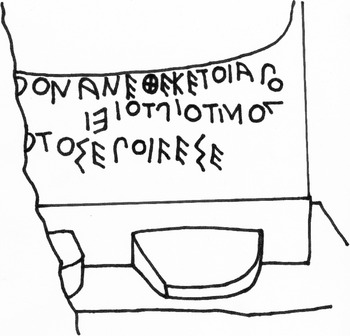
58. Drawing of fragmentary Boiotian kore from the Ptoon, signed by […]OTOS, c. 625 (?). Athens, National Museum 2. Drawing after Jeffery Reference Jeffery1990, pl. 7 (no. 4).
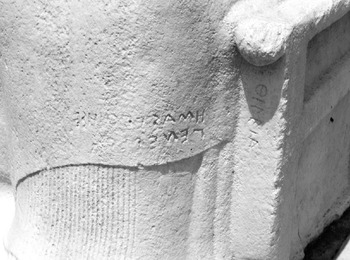
59. Signature of Geneleos on the robe of Phileia (her name is inscribed on the leg of her chair); c. 550 BCE. Samos, Vathy Museum.
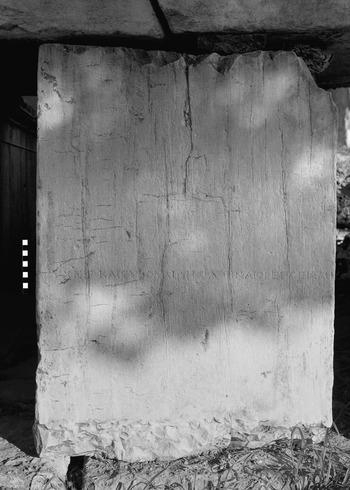
60. Base of monument from Athenian Agora, signed by Eukheir and Euboulides; late 2nd century (IG II2 4297).
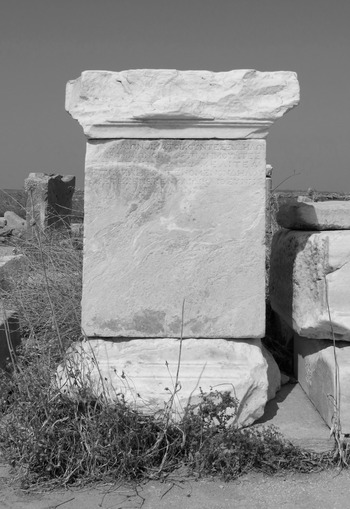
61. Base of portrait statue of Epigenes, signed by Hephaistion, son of Myron. ID 1643. Delos, 127/6 BCE.
The numbers strongly suggest, then, that the signing of Greek sculpture was uncommon and erratic in every period. But the statistics, striking though they may be, almost certainly do not tell the whole story. Obviously, there were originally many more sculptors’ signatures than happen to have survived; and so, surely, the physical evidence we have is insufficient to describe ancient realities. Accidents of preservation probably distort the picture here more than in any other genre save metalwork and wall-painting, though in most cases accident had nothing to do with it (the Persians did not accidentally destroy the Acropolis in 480 BCE; the Roman general Sulla did not accidentally pillage Athens in 86 BCE; Nero did not accidentally order the looting of five hundred bronze statues from Delphi; thousands of bronze statues throughout Greece were not accidentally ripped from their bases and melted down for their raw materials at and after antiquity's end; thousands of emptied marble bases were not accidentally burned for lime or recycled as building blocks in later walls). The gaps in our evidence are often, it is true, yawning. We do not have – we cannot even read about – a single undisputed signature of the greater Polykleitos of Argos (Polykleitos the Elder, as opposed to lesser or Younger Polykleitoi who came after him).24 But we do not have any original statues by the master, either – just Roman-era “copies” or adaptations [Fig. 8]. And it is impossible to believe that the sculptor who famously wrote a treatise on proportion, the nature of beauty, and symmetria* – the Kanon, a papyrus book-roll whose “title page” (or its equivalent, a tag or sillybos*) must have included his name – did not somewhere sign the lost bronze statue that he made specifically to illustrate and literally embody its theoretical principles (almost certainly the Doryphoros): without signatures on both book and bronze, the whole point – the connection between theory and practice – would have been lost. So, too, we have no signature of the renowned 4th-century sculptor Timotheos (though he is named in the building accounts of the Temple of Asklepios at Epidauros) or the great 4th-century sculptor (and architect) Skopas,25 or the painter and sculptor Euphranor (though we do have a large portion of what is probably his marble Apollo Patroos from the Agora). But we are told that Euphranor also wrote treatises on symmetria and colors (we presume he claimed authorship), and we know that his son, the minor sculptor Sostratos, signed at least three statue bases: if the son, why not the father?26 There are, besides, many indications in our ancient literary sources of a wealth of signed works in cities and sanctuaries large and small. Even fictional characters comment upon them. In Herodas’ Fourth Mimiambus (c. 250 BCE), two women visit a shrine of Asklepios and one (Kynno) points out to the other a statue base with the signatures of the sons of Praxiteles (presumably Kephisodotos and Timarkhos): “do you not see those letters on the base?” she says. Whether the setting of the poem is an imaginary Asklepieion or a real one (the sanctuary on Kos, perhaps), such experiences must have been common.27
Often, it is true, the quite historical Pausanias merely reports what he is told by his local guides, and sometimes not even the guides have any information about the artists: Pausanias must occasionally contend with gaps in institutional memory or lapses in oral traditions, with no signatures to help.28 In Pausanias’ day, it seems, most visitors to major sanctuaries would have been told what they were seeing. Still, Pausanias was not your average tourist, and when signatures were there, he seems, for the most part, to have read them, even if he does not regularly report doing so.29 And so one easily imagines Pausanias furiously jotting down names of all kinds as he toured, say, Olympia and its forest of statues. In fact, we do not have to imagine it. When he notes a statue of Zeus near the Bouleuterion dedicated by the Greeks who defeated the Persians at Plataia, he records at great length the list of cities inscribed on its pedestal and, at the end, notes that the statue was made by Anaxagoras of Aegina: Pausanias undoubtedly knew that because the otherwise text-rich base included a signature.30 Similarly, when he notes that a group of Herakles and the Nemean lion was dedicated by Hippotion of Taranto and was made by Nikodamos of Mainalos, the information must have come from the preserved inscribed base.31 When he describes the great Early Classical Akhaian Monument that spanned the Sacred Way near the southeast corner of the Temple of Zeus, with eight bronze heroes about to draw lots from Nestor's helmet to see who will fight Hektor, he records not only the inscription on the base:
but also the signature of the immodest sculptor engraved into Idomeneus’ shield:
And when he visits the grove of the Muses on Mt. Helikon and comes upon, first, a group of the goddesses by Kephisodotos, then three more Muses by Kephisodotos, then another three by Strongylion (late 5th century), and then another three by Olympiosthenes (about whom we know nothing else), it is hard to see how he could have identified the artists without information supplied by signed bases.33
The impulse for self-identification among Greek sculptors of all periods may not have been irresistible, but it was not weak, either. And beginning with Euthykartides [Fig. 1], many Greek sculptors sign their works (or have someone else inscribe their names for them) in a variety of different ways and places.
1. They can inscribe their names directly upon the bodies of their statues or upon the frames of their figured reliefs (as opposed to their bases). The Boiotian […]OTOS, for example, signed his early korē on the lower edge of her garment directly below the dedication to Apollo Ptoos (the letters are all of the same size and style, and the signature is probably an autograph) [Fig. 58], and the Naxian Nasstiades carved his name into the belt of his early kouros from Delos.34 In the Archaic period this practice seems especially popular in east Greece: EUDEMOS ME EPOIEN (Eudemos made me) is written along the arm of the throne occupied by one of the so-called Branchidai from Didyma, and the retrograde HĒMAS EPOIĒSE GENELEOS (Geneleos made us) appears on the front of the mantle of the seated female figure from his six-figure group portrait on Samos (her name, Phileia, is cut less conspicuously into the leg of her chair) [Fig. 59].35 But sculptors continue to sign their statues directly from time to time down to (and past) the Hellenistic period: again, Onatas (calling himself sophos) signed the shield of Idomeneus at Olympia in the early 5th century; Boethos of Kalchedon signed the shaft of his bronze herm from the Mahdia shipwreck; Apollonios, son of Nestor, the Athenian, made [it] is inscribed upon the rocky seat of the powerful Belvedere torso (c. 50 BCE) [Fig. 62]; and, later still, Athanadoros, son of Hagesandros, and Hagesandros, son of Paionios, and Polydoros the son of Polydoros, Rhodians, made this is inscribed on the panel on the side of the ship of the Skylla group from Sperlonga [Fig. 7].36
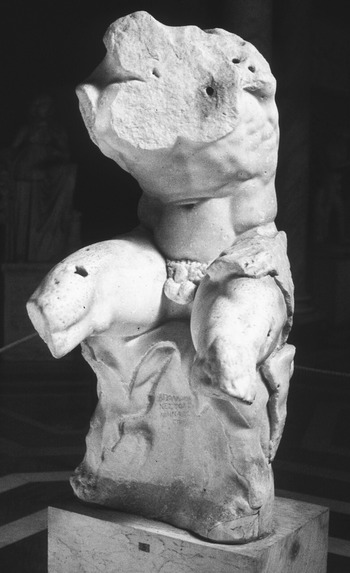
62. The Belvedere Torso, signed (on the rock, below the legs) by Apollonios, son of Nestor, the Athenian. c. 50 BCE. Vatican 1192.
It bears repeating that (outside of Attica) dedications and the names of subjects were commonly engraved directly onto statues, too.37 There are, again, the dedications on the Mantiklos Apollo and the Nikandre korē and the one written above […]OTOS’ signature on his korē from the Ptoon [Fig. 58]. There is the dedication of Pythias of Akraiphia and Aiskhrion written in two lines down the left thigh of Ptoon 20, with two more lines about Apollo of the silver bow written down his right (there is no signature anywhere, but one might have appeared on the kouros’ missing lower legs or base).38 There are Kheramyes’ dedications written on the front of his several korai, or Isches’ cut into the left quadriceps of the colossal kouros he commissioned, or the names Phileia, Philippe, Ornithe, and…arches inscribed on the statues Geneleos made [Fig. 59], or the dedication of Aiakes written on the chair of a seated statue – all from Samos.39 So, too, at Olympia Pausanias records that the name Agamemnon was engraved (retrograde) on the bronze statue of the king in Onatas’ Akhaian Dedication. And there he also saw a 5th-century bronze mare (the ugliest horse in the entire sanctuary, he says, though flesh-and-blood stallions were inexplicably and passionately attracted to it) that had a dedication by Phormis of Mainalos inscribed on its flank; Pausanias also notes that the horse and the man who led it on foot were the work of Dionysios of Argos – information he probably gleaned from a signature on the group's base.40 Dedications and epitaphs may have been paired with signatures, or not, but a signature usually did not occur by itself. And when all that remains is a signature – LEOBIOS EPOIESEN PYRETIADES, for example, on a late Archaic base from the Acropolis, or LYSIPPOS EPO[IESE] on two signed late Classical bases from Corinth [Fig. 57] – it is not because the artist's name was the only thing that mattered: we can be fairly confident that a dedication was inscribed directly on the bronze statue Leobios, son of Pyretiades, made and signed (probably a horse or horse and rider), and that a bronze plaque (presumably containing a dedication) was attached to at least one of the Lysippan bases.41
As for reliefs, signatures can be inscribed not on the figures themselves but along the edges or “frames” surrounding them. On the late 6th-century funerary stele of an Athenian who was, or once had been, a hoplite, the name of the deceased – ARISTIONOS (of Aristion, with something like sēma or “tomb” implied) – appears on the base, while on the lower edge of the relief itself, just below Aristion's feet, the sculptor has signed ERGON ARISTOKLEOS (work of Aristokles) [Figs. 63, 64]. So, too, on the late Archaic grave stele of Mnasitheios from Akraiphia in Boiotia, a five-line-long epitaph is written vertically in the field next to the youth, but PHILORGOS EPOIESEN (Philourgos made it) appears separately below the groundline or border on which the youth stands. On the roughly contemporary Potter's Relief from the Acropolis [Fig. 50], where a seated artisan holds a couple of cups in his hand, both dedication and signature (now reduced to a few letters each) were incised into the narrow vertical edges of the frame (the dedicator could have been Pamphaios, the sculptor might have been Endoios). And on the bottom edge of a late Archaic grave stele from Boiotia, an itinerant Cycladic sculptor made sure we would be impressed by the strongly foreshortened right foot of an old man leaning on his staff and tempting his dog with a bug: the inscription reads Alxenor of Naxos made [me]. Simply behold! [Figs. 65, 66]. The brief but grandiloquent imperative (it echoes a phrase in the Iliad) converts the signature into a Homeric hexameter, and it is the only text to survive: the name of the deceased must have appeared on another section of the (damaged) frame or on the stele's base.42
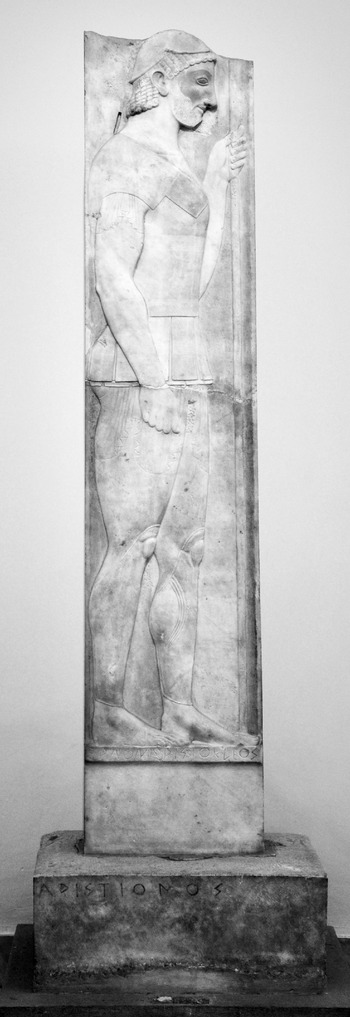
63. Funerary Stele of Aristion, by Aristokles. c. 510 BCE. Athens, National Museum 29.
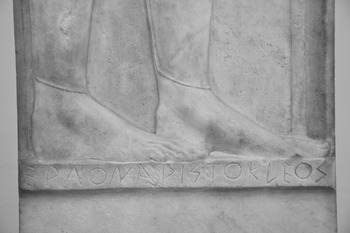
64. Funerary Stele of Aristion, detail of signature of Aristokles.
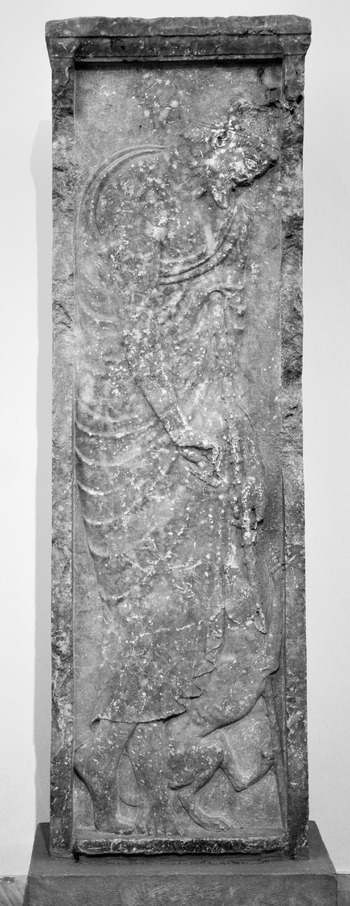
65. Funerary stele from Orchomenos (Boiotia), signed by Alxenor. c. 500 BCE. Athens, National Museum 39.
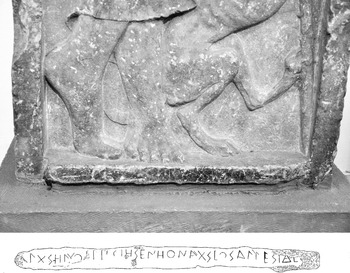
66. Detail of signature on funerary stele signed by Alxenor. Photo: author; drawing of inscription from Loewy Reference Loewy1885, no. 7.
2. Sculptors on occasion signed the plinths of their statues (either the blocklike supports carved out of the same stone as, and of a piece with, the figures standing above, or the bronze plates atop which bronze statues stood, as opposed to separately carved stone bases). There are several damaged and obscure inscriptions written across the tops of the plinths (both beside and between the feet) of the twin marble kouroi still best known as Kleobis and Biton at Delphi (c. 580 BCE). We do not know which one is Kleobis and which Biton, but on the edge of the plinth of “Statue B” is the retrograde signature [Poly]medes the Argive made [us] [Fig. 67].43 More texts might have been written upon the base (or bases) into which the statues and their plinths were set. An under-life-size bronze statue dedicated at Olympia c. 500 BCE by the city of Byzantion stood on a bronze plate, inscribed with the signature of Pelanidas of Aigina, that was itself set into a limestone base.44 And centuries later, the signature [Alex- or Ages]andros, son of Menides, from Antioch on the Meander, made [it] was engraved on the (broken) plinth of the famous late 2nd-century Aphrodite from Melos (a.k.a. the Venus de Milo) in the Louvre.45
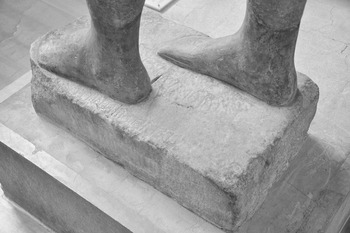
67. Plinth of Statue B (either Kleobis or Biton), signed by [Poly]medes of Argos; c. 580 BCE. Delphi 467, 1524.
3. But, of course, most signatures, by far, are found on bases – low blocks of stone, high blocks, round blocks, pillars, columns, and so on. They can be engraved into the flutes of columnar bases where dedication and signature are separated only by sharp arrises. On a column that probably supported Acropolis Kore 602, for example,
is written vertically (left to right, top to bottom) in a central flute and
is engraved in the flute immediately to the left (in a sense, “below” the dedication) [Fig. 68]. Both of these lines were cut by the same hand – probably the sculptor's. But two flutes to the right of the dedication (and so “above” it), there is a second signature:
written in a different hand, and the best explanation is that Opsios commissioned a statue from the workshop of the master Endoios, that the work was executed (and the initial texts inscribed) by a member of his shop, Philergos, but that after completion Opsios requested that the renowned Endoios add his own name, and that the master complied in his own hand (though leaving an empty flute between the dedication and his own signature). That is, Philergos, the actual sculptor of the statue, took credit for his work, but the dedicant wanted the additional prestige of Endoios’ name affixed to the monument.46 If this reading is correct, epoiesen can on rare occasions mean for sculptures what it can sometimes mean for vases: “this came out of the workshop of X.”

68. Fragmentary columnar base supporting a dedication by Opsios, signed by Philergos and Endoios. Athens, Epigraphical Museum 29. Drawing after Viviers Reference Viviers1992, fig. 5.
A few other Acropolis monuments were also inscribed by more than one letterer. Around 500, for example, an under-life-size statue (probably an Athena) was installed atop a tall fluted column engraved with the inscription:
Signature and dedication were written (vertically, in three adjacent flutes) by very different hands – the letters of the signature are noticeably smaller and in a less precise style – and that suggests that Pythis autographed the monument, either before presenting it to Epiteles (who presumably hired a mason to carve his dedication to Athena from the first fruits [aparkhen] of his labors) or afterward, at Epiteles’ request [Fig. 69].47 And on a later column supporting another under-life-size Athena (c. 470 BCE), three adjacent flutes contain the vertical lines
Dedication (first two lines) and signature (last line) are again the works of different letterers, and so it is likely that the Euenor's signature (like those of Philergos, Endoios, and Pythis before it) was an autograph [Pl. XIII, Fig. 70]. In the case of Euthykartides’ rough triangular base, again, the inscription begins on the top and descends down the left side, drawing the viewer (who was also a reader) away from a purely frontal experience of the kouros above [Pl. I, Fig. 1]. In the case of rectangular bases, signatures can occasionally be written on the upper surface of the block, like the signatures of a Polykleitos – almost certainly the Younger – engraved beside the feet of bronze statues of Pythokles of Elis and Aristion of Argos at Olympia.49 And they can be written on the sides of bases, around the corner from the dedication or epitaph. This is, again, a habit of Aristion of Paros [Fig. 56], but he is not alone: at least 14 monuments from the Acropolis had dedication and signature inscribed on different faces of the stone. There is, for example, the pillar base for a bronze horse, or horse and rider, dedicated by Timarkhos (the dedication is engraved on a narrow side of the base) and made by Onatas (whose signature in found by itself on the broad left side of the abacus [Fig. 71]).50 Such a separation clearly distinguishes signature and dedication, but it is not a matter of banishing the artist to a less important side of the monument, minimizing his role or subordinating it to the dedicant's. In fact, the viewer had a better perspective on the bronze horse from the side with Onatas’ signature, and it is possible that the tactic was meant to encourage the viewer to move around the monument and so appreciate it from more than one point of view, as well as to call attention to the artist's name on its own terms.51
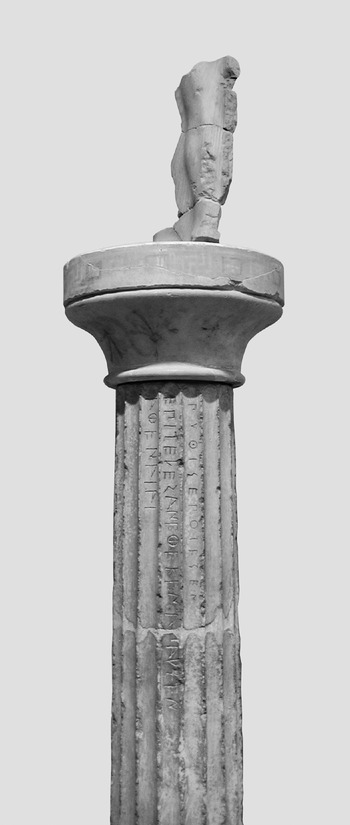
69. Columnar base for dedication of Epiteles, signed by Pythis. Acropolis Museum 9, 136.
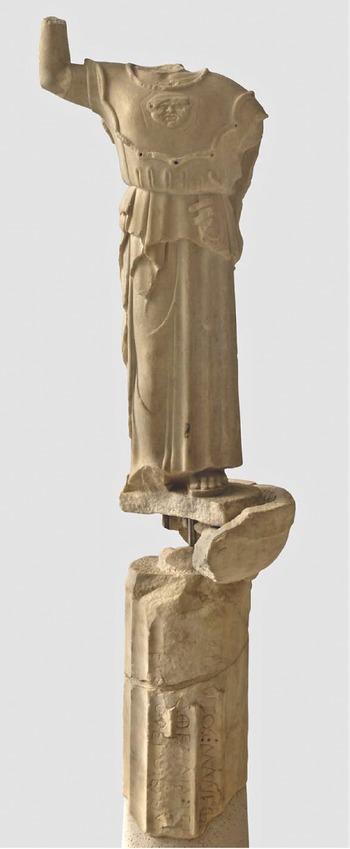
XIII. Statue and base of Athena dedicated by Angelitos, signed by Euenor; c. 470 BCE. Acropolis Museum 140.
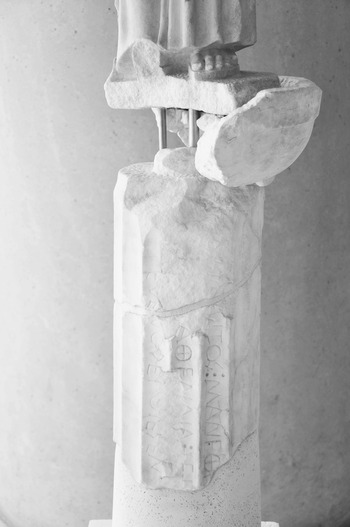
70. Inscribed base of Athena dedicated by Angelitos, signed by Euenor; c. 470 BCE. Acropolis Museum 140.
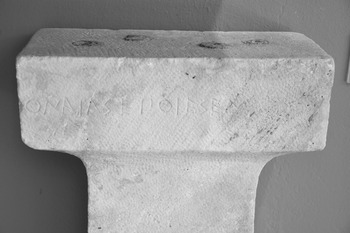
71. Signature of Onatas on a pillar base supporting a dedication of Timarkhos. Athens, Epigraphical Museum 6263.
But, of course, signatures are most often inscribed across the front face of the base in some kind of direct relationship with a dedicatory or funerary text. In the Archaic and Classical periods it is common to have dedication and signature written together in one continuous textual “block” – that is, in a formation of equally spaced, stylistically homogeneous lines, with little or no typographical or even syntactical distinction between them. So, for example, on a base in New York dated c. 550 BCE, there is an elegiac couplet written boustrophēdon in just over two lines (the inscription thus ignores the poetic form) [Fig. 72]:
The signature PHAIDIMOS EPOIE (though it is prose, not poetry) shares the last line with the word concluding the couplet and is written by the same hand, in letters of the same scale.52 On the base of a funerary korē that Phaidimos made for the grave of a girl named Philē (c. 550 BCE) [Fig. 73], there is another elegiac couplet (probably cut by the same hand that inscribed Phrasikleia's epitaph, Fig. 55), but this time a different verb has been chosen (ERGASATO instead of the usual EPOIE) so that the signature properly scans:
That is, the signature is incorporated into the dactylic pentameter that concludes the epigram: it is metrically a continuation of the poem, not a prose appendage as it is on the base in New York. On the stone itself, the last of the three inscribed lines is devoted to the signature alone (written in letters as fine, deep, and large as the rest), but PHAIDIMOS ERGASATO is preceded by a punctuation mark (three vertical dots) and a conjunction – aFutar (“but,” “and yet”) – that establish a quick (and somewhat jarring) transition from the words of sorrow above.53 So, too, in the inscription on the funerary monument of Lampito [Fig. 74], the third and last line begins with the end of an elegiac couplet – the inscription again ignores the verse form – but it concludes with ENDOIOS EPOIESEN, written in letters of the same size and style (only a punctuation mark separates epitaph from signature):
Endoios’ signature, in other words, is technically not part of the poem, yet it shares the last line with the poem's last word. It is once again integrated into a continuous text; it and the epitaph form a single graphic formation or block. And there are Classical fusions of dedication and signature, too: on a base from the Acropolis datable to c. 450 BCE the second line of Peikon's dedication to Athena evidently ended with [KRES]ILAS EPOIE.54
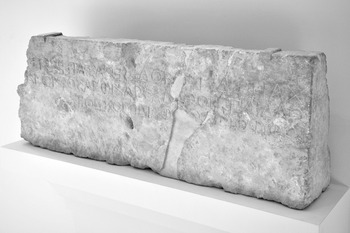
72. Base for funerary monument of Khairedemos by Phaidimos, c. 550 BCE. (Phaidimos’ retrograde signature appears at the end of the last line). New York, Metropolitan Museum of Art 16.174.6.
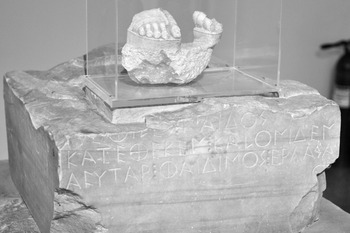
73. Base of the funerary korē of Philē, signed by Phaidimos, c. 550 BCE. Athens, National Museum 81.
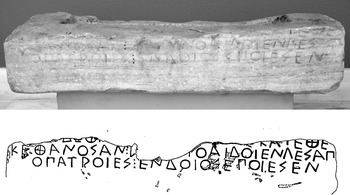
74. Base of the funerary monument of Lampito, signed by Endoios, c. 525 BCE. Athens, Epigraphical Museum 10643.
It is common Archaic and Early Classical practice for the first word of the dedication to be the name of the dedicant, and for the last words of the text to be the signature of the sculptor, given its own line directly below the dedication, with the same spacing and epigraphically identical letters.55 The simplest formula is found on a low base from the Acropolis (c. 500 BCE) – it once supported three bronze statuettes – where the text is inscribed stoikhēdon and is thus a single typographical unit [Fig. 75]:
The same formula is repeated over and over again, as, for example, in the stoikhēdon inscription on the base of a lost bronze statue representing and dedicated by an extraordinary champion boxer at Olympia, made and signed by Pythagoras of Samos around 470 BCE, and, in Pausanias’ opinion, “well worth seeing”:
And the formula bears expansion: on the late 6th-century funerary monument of Xenophantes [Fig. 76], ARISTOKLES EPOIESEN occupies the entire last line of a five-line text, and the letters of the signature are as big and as deeply cut as those of the epitaph directly above (though they seem written in a different hand – the sculptor's own, presumably).58 Signature and epitaph once again constitute a single textual block: there is no spatial and little typographical distinction between them.

75. Base for a dedication of Phsakythe, signed by Hermippos; c. 500 BCE. Athens, Epigraphical Museum 6250.
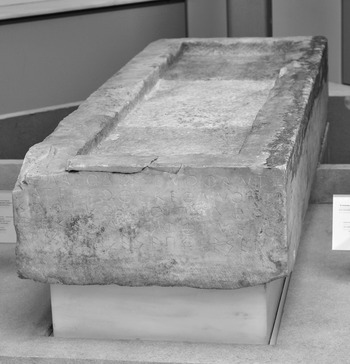
76. Base for funerary monument of Xenophantes, signed by Aristokles. Kerameikos Museum I 389.
And no such distinction is found on various Early Classical monuments signed by such well-known sculptors as Kalamis or the famous team of Kritios and Nesiotes. On the base of a statue of Aphrodite that Pausanias saw inside the Propylaia, for example, there is the simple four-line, four-word stoikhēdon inscription
with the names of dedicant and artist identical in size and style, while another Acropolis base that supported a bronze statue of a hoplitodromos (an armed runner) is inscribed in two lines, stoikhēdon:
Again the names of dedicant and sculptors are typographically equivalent. The same double signature appears elsewhere on the Acropolis – for example, as the last of six lines on a rectangular base for the dedication of Hegelokhos (a bronze action statue commemorating Ekphantos), and as the last of three lines on a circular base for the dedication of Aristeas and Ophsios (probably an Athena standing at rest).59 It is likely that all the bases signed by Kritios and Nesiotes were engraved by the same letterer – a member of their atelier, perhaps, one who treated dedication and signature as elements of the same continuous text, with equal spacing between all lines.
Still, typographic distinctions between dedication or epitaph, on the one hand, and signature, on the other, often appear in the 6th and 5th centuries. There is, for example, the very unusual case of the late 6th-century funerary monument of Leanax: a (lost) seated statue upon a wide, inscribed base [Fig. 77]. The first two lines of the text tell us that the deceased was a Samian of noble birth who died far from his loved ones – this, after all, is an Athenian monument. The third and last line is the signature PHILERGOS EPOIESEN, but the letters are much more deeply cut and are nearly twice as high as those of the comparatively understated epitaph (4.5 to 2.5 centimeters), so the signature overshadows the lines above. The epitaph still comes first and occupies the top of the stone, and both epitaph and signature were evidently cut by the same hand. But they are not of the same kind, and it is the signature (and the artist), not the epitaph (and the dead), that grabs the attention of the viewer/reader. It is possible, in fact, that the engraver of both texts was, again, Philergos himself – now, apparently, out from under the shadow of Endoios [cf. Fig. 68].60

77. Base of funerary monument of Leanax of Samos, signed by Philergos. Courtesy 3rd Ephorate of Prehistoric and Classical Antiquities, Athens (M 662)
The Archaic and Classical letterer clearly had a number of epigraphic options from which to choose, and it is the variety of formats that needs emphasizing. He could, for example, abandon the single text “block” formation and separate dedication (or epitaph) and signature, either by putting the signature on a different side of the base (as in the case of Aristion of Paros, Figs. 55, 56) or Onatas [Fig. 71], or by putting signature and epitaph on opposite sides of a figure and orienting them differently (as on the base of the funerary kouros of Neilonides made by Endoios c. 530–520 BCE, Fig. 78),61 or simply by putting empty space between them, thus establishing a balance or juxtaposition between the texts rather than a linear sequence or continuum. On the short end of a long base for a marble horse (or horse and rider) set up on the Acropolis c. 510–500 BCE, a simple dedication (as usual beginning with the name of the dedicant) occupies three lines at the top
appears by itself considerably below, across uninscribed, vacant stone [Fig. 79].62 The letters of Gorgias’ signature are still in the same style and are of the same size as those in the dedication above, but the distance seems to establish an equivalence or parity between the names of dedicant and artist. A little earlier, perhaps, on the base of a massive Acropolis korē (probably an Athena) dedicated by Nearkhos [Pl. X] – possibly but not certainly the same Nearkhos who potted and painted vases earlier in the century [Fig. 38]63 – dedication and signature are “justified” flush left:
But the signature is placed a little more than 4 centimeters below the dedication, and the letters (though clearly cut by the same mason) are a little smaller, too.64 Moreover, while both the dedication and the signature are each engraved stoikhēdon, each is plotted according to its own distinct grid. All in all, the Gorgias and Antenor bases are two of many that suggest an emerging conceptual separation of signature from dedication in the late 6th century. And the trend continues into the early 5th century with such monuments as one dedicated by Aristion and Pasias and made by Hegias [Fig. 80]. The sculptor's signature is located one line or space below the dedication, though in this case its letters are of the same size and are cut to the same depth as the text above.65
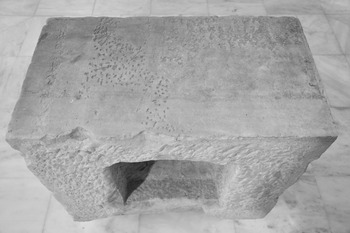
78. Base of the funerary kouros of Neilonides, signed by Endoios, c. 530–20 BCE. Athens, Epigraphical Museum 12870. Endoios’ vandalized signature was written vertically, at left, the epitaph at upper right.
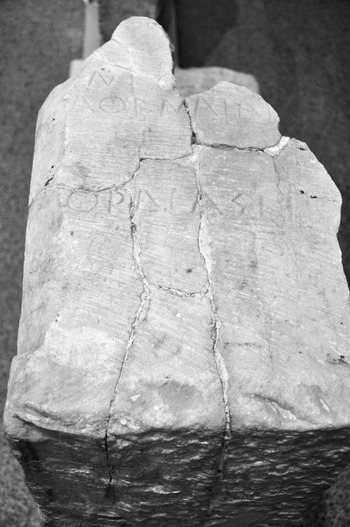
79. Base for a dedication by Hegesandros from the Acropolis, signed by Gorgias; c. 510–500. Athens, Epigraphical Museum 6244.
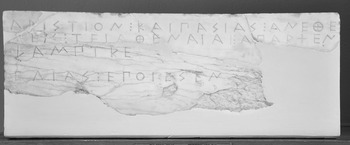
80. Base of dedication of Aristion and Pasias, signed by Hegias; c. 490–480 BCE. Athens, Epigraphical Museum 6299+6247.
Such a separation does not necessarily diminish the “presence” of the sculptor: on an Early Classical pillar monument from the Acropolis, for example, Euphron's signature is set considerably below the five-line dedication, but its font size is much larger, which emphasizes Euphron's role in the creation of the votive.66 Still, well into the 5th century options remain open, even for different monuments made by the same artist. On the base of Pyres’ dedication to Pallas Athena (often dated to c. 450–440), the signature appears as the last of three evenly spaced lines all cut by the same hand:
The first line is a dactylic hexameter, the second a pentameter. The signature (Kresilas of Kydonia made [it]) is itself an iambic trimeter, so it is part of a single epigraphical and poetic (but non-stoikhēdon) formation.67 But on the base of another statue by Kresilas dedicated on the Acropolis, dedication and signature (both carved stoikhēdon, neither poetic) have completely different alignments [Fig. 81]. The three-line dedication by Hermolykos, son of Dietrephes, is above (as we would expect) and is aligned along the left-hand edge of the block. But Kresilas’ two-word, two-line signature is not only placed at some distance below the dedication, but is also shifted to the right, so that it is centered on the stone; its letters are on a smaller scale, too. As a result, the emphasis seems to oscillate between dedication and signature: the centrality and symmetry of KRESILAS EPOESEN seem to privilege the sculptor, but the smaller size of its font makes the signature seem subsidiary to the dedication.68
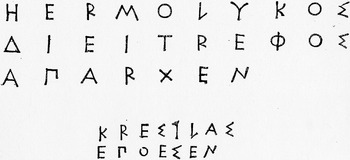
81. Dedication and signature on the Hermolykos base (IG I3 883), c. 410 BCE. From Loewy Reference Loewy1885, no. 46.
At the end of the 5th century signatures can still be written contiguous to, and in the same style and size as, the associated dedication. Around 430 (or a little later), for example, the Athenian demos dedicated a statue of Athena (in her role as Hygieia, goddess of health) on a circular base that was cut away to fit against the southeast corner of the Propylaia [Figs. 82, 83]. The two-line text reads:
The inscription is not the finest example of Attic epigraphy that we have (the lines are not quite horizontal, for example), and the difficulty of engraving a curved surface may have had something to do with that. But the dedication once again occupies the top line (and the name of the dedicant – ATHENAIOI, the Athenians – is once again the first word); the signature of Pyrrhos the Athenian is once again inscribed directly but asymmetrically below; and the letters in both lines are of the same size and depth.69 The base displays the kind of linear (and hierarchical) sequencing of dedication and signature that had been familiar since the 6th century.
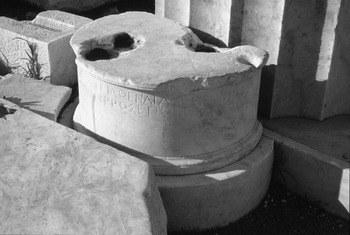
82. Base of a statue of Athena Hygieia, dedicated by the Athenian people and made by Pyrrhos; c. 430–425 BCE. Acropolis.

83. Inscription on the Athena Hygieia base. From Loewy Reference Loewy1885, 45 (no. 53).
But not much later the base of a monument on the grounds east of the Temple of Zeus at Olympia was engraved with an inscription that in some ways anticipates a format that will dominate in the late Classical and Hellenistic periods. On the bottom block of a tall triangular pillar that supported a spectacular winged marble Nike descending dramatically from heaven to announce a victory in the Peloponnesian War, there is the text [Pl. XIV]:
There is a gap of a few centimeters between dedication and signature. The alignment of the signature is different, too: it is indented, shifted a little to the right. But it is the tiny size of its letters that stands out: signatures had occasionally been smaller than associated dedications before [cf. Pl. X], but not as small as this.70 It would be tempting to conclude that the contribution of the sculptor to the monument is being minimized through typography, except that the dedication itself is also very small compared to the size of the block on which it is carved (much less the height of the entire monument), that Paionios’ signature is still fairly conspicuous on the front of the base (it would have been even clearer when the engraved letters were filled with red paint), and that the signature, though unusually small, is also unusually long and informative, boasting of Paionios’ victory in a competition to make the akroteria (roof ornaments) for the nearby Temple of Zeus – just as the Messenians and Naupaktians commemorated their defeat of the Spartans in 425 BCE with the Nike they commissioned Paionios to carve. Statue, dedication, and signature are all about victory, and whoever inscribed the text is hardly diminishing or marginalizing the sculptor's role or status.71 If such marginalization were the point, the signature of Paionios would not be there in the first place. But it is there, because the name of the sculptor and the nature of his success mattered: the signature, read aloud, bestowed kleos upon him, and the golden glow reflected back upon the Messenians and Naupaktians themselves.
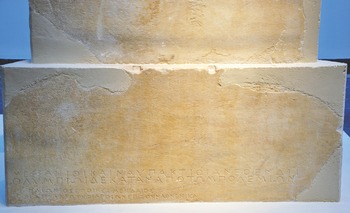
XIV. Inscribed base of the marble Nike dedicated by the Messenians and Naupactians just after 425 BCE, signed by Paionios of Mende. Olympia Museum 46–8.
And yet the small size of Paionios’ signature seems to anticipate Late Classical and Hellenistic practice, when it is increasingly common to find the artist's signature not only at some distance below the dedication, but also written in letters only a centimeter high (or even less). We have already noted the format on the base that supported the statues of Spoudias and Kleiokrateia by […]ysikles and Praxiteles [Pl. XII, Figs. 52, 53]. The signature of Bryaxis on a tripod base in Athens is another example [Fig. 84]. Bryaxis is one of four masters said to have been responsible for the sculptures of the Mausoleion at Halikarnassos, and so he was no minor player on the stage of Late Classical sculpture. Yet the base itself is undistinguished. Three sides are carved with nearly identical and monotonous scenes of a horseman approaching a tripod (the direction of the approach is the only major difference): these reliefs, we would like to believe, are the work of a member of Bryaxis’ shop rather than of the master himself, while the lost bronze tripod above would have been Bryaxis’ own work. At all events, the fourth side is inscribed, above, with a deeply cut, four-line text naming three Athenian tribal commanders (phylarchs) who were victorious in a mock cavalry battle known as the anthippasia and, below, with the minuscule and faint line BRYAXIS EPOĒSEN [Fig. 85].72 The typography and position of the signature exemplify the standard hierarchy, in which the importance of the dedicant or honorand is greater than that of the artist (though it could still be argued that the small size of the signature paradoxically draws attention to it, necessitating a closer reading, just as the tiny integrated signatures on Syracusan coins do [cf. Pl. VI]). And the format seen on the Bryaxis base seems to harden in the Hellenistic period. On the bases of the 3rd- and 2nd-century portrait statues from the dromos on Delos, for example, the sculptor's signature invariably occupies a separate line well below the dedication [cf. Fig. 61]. Again, there was nothing new in that, but it is inscribed in much smaller letters as well, and though the dedication and the signature are typically cut by the same hand, that hand was usually not the artist's.73 It was, again, the patron or client who usually determined what was written, who wrote it, and how.
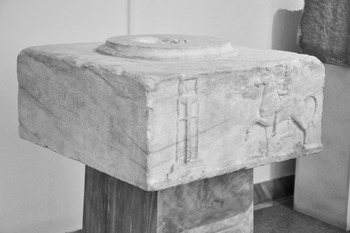
84. Base for a bronze tripod commemorating a victory in the anthippasia competition, signed by Bryaxis; c. 350 BCE. Athens, National Museum 1733.
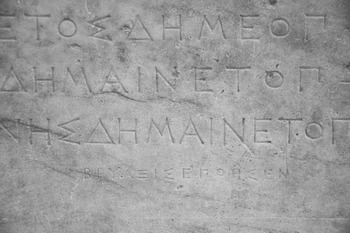
85. Bryaxis base, detail of signature.
But there are enough exceptions to suggest that, no matter how common the formula “large dedication, minuscule signature” came to be in the Late Classical and Hellenistic periods, it was not an inviolable rule. There remains, for example, Praxiteles’ more emphatic signature on the Arkhippe base [Fig. 54], where the distance between dedication and signature, written on nearly the same scale, again establishes a kind of equivalence between them, not a hierarchical ranking. There are those two empty bases in Corinth, where Lysippos's signatures – the only texts cut into the stones – are relatively large (3 centimeters high) and emphatic [Fig. 57]. Another Lysippan signature, on the base of the statue of Pelopidas at Delphi, was part of a single textual formation in stoikhēdon – the letters of the signature are of the same size and depth as the rest. Another (now lost) Lysippan signature, on the base of a bronze statue of the champion pankratiast Agias at Pharsalos, adhered to the same stoikhēdon grid as the dedication above (written in elegiac couplets), but LYSIPPOS SIKYŌNIOS EPOIĒSEN was prominently centered one space below the dedication – seemingly set off for emphasis – and the letters were again the same size: there was no attempt to minimize the sculptor's role here.74 Nor is there such an attempt on a base recently discovered at Thebes, where yet another Lysippan signature (LYSIPPOS SIKYŌNIOS EPOĒSE) occupies the line directly below the dedication (by Hippias, son of Erotion, to Zeus Soter). As they often did in the Archaic period, dedication and signature form a single typographical block which, in this case, is set considerably below another, lengthy patriotic text concerning the general whose bronze statue stood above. This distance, as well the tight pairing of the lines, emphasizes both the piety of the patron and his discernment in hiring Lysippos to do the job.75 As for Hellenistic exceptions, there are a number of late 2nd-century bases from the Athenian Agora where signatures such as
or
appear all by themselves on the face of a stone that is otherwise uninscribed [Fig. 60]. The letters are small (they are 0.9 and 1.5 centimeters high, respectively), but the isolation of the signatures still sets the sculptors apart, emphasizing their role.76
4. One expects to find signatures on bases. But they were occasionally found in less obvious places. Somewhere inside the Parthenon, Plutarch informs us (though just where he does not say), a stele stood declaring that the great chryselephantine Athena Parthenos (dedicated in 438 BCE) was the work of Pheidias. The statement of agency, then, appeared on a discrete object, a slab that was probably placed not far from the base of an image that was itself unsigned and textless (like most cult statues, apparently).77 But we cannot in fact be sure whether the stele bore a true signature or merely a record or attribution. It is possible that Pheidias had the stele inscribed with his name and set it up himself at the time of the statue's installation, especially since we know that Pheidias scratched his name on far humbler things (like a simple black-glazed drinking cup found in his workshop at Olympia) and that “below the feet” of his slightly later but even greater chryselephantine statue of Zeus at Olympia – a wonder of the ancient world, datable to the late 430s – there was, Pausanias tells us, the simple line
It is unclear what Pausanias means by “below the feet” of the statue. But if it means on the enthroned god's footstool (decorated with gold lions and an Amazonomachy) or some other low part of the statue itself (as opposed to, say, a molding between statue and base) the signature would have been of a piece with the image above, rendered in the same technique in gold and ivory. And that would indicate that the signature on the Zeus was Pheidias’ autograph, an integrated signature that was part of the fabric of a statue that was said to have added something to traditional religion (no mere banausos, he, this friend of Perikles and Anaxagoras, this greatest sculptor of gods). But the naming of Pheidias on the Parthenon stele seems different: it means that the Athena Parthenos was itself unsigned but still required a statement of authorship.79 And so it is possible that the stele was more in the nature of a museum label, set up at some point after 438, perhaps soon after the completion of the Zeus later in the decade, as a kind of anxious Athenian response to it. The Temple of Zeus at Olympia and the Parthenon influenced and rivaled each other in a number ways, and when the Athenians learned that Pheidias had directly signed his Zeus at Olympia, after having left their Athena unsigned, they may well have set up the stele to inform or reassure visitors to the Acropolis (Athenian and non-Athenian alike) that the great sculptor had made their chryselephantine deity, too.80 The name lent the image prestige. But, in that case, Pheidias himself would have had nothing to do with it.
At Epidauros Pausanias saw an inscription (epigraphē) stating that the early 4th-century chryselephantine cult statue of Asklepios – half the size of the Zeus at Olympia – was the work of Thrasymedes, son of Arignotos, of Paros. He neglects to tell us whether the text was found on the statue itself, its base, or on a separate stele, and so we cannot be sure the signature was an autograph.81 But he does tell us that in a temple near the Pompeion, at the northwest corner of Athens, there were statues of Demeter, Kore, and a torch-bearing Iakhos, and that “an inscription in Attic letters on the wall declares that they are the works of Praxiteles.” A wall is an even more unusual place for the signature of a sculptor than a free-standing stele, and it is possible that an inscribed plaque was put there during a restoration of the temple centuries after Praxiteles.82
5. Finally, signatures are found even on architectural sculptures, though very rarely. The only certain Archaic instance appears on the north frieze of the Siphnian Treasury at Delphi (c. 525 BCE), where a sculptor signed his name around the rim of a shield of a giant labeled (in paint, originally) Alektos: he advances in a phalanx of three against Apollo and Artemis [Fig. 86]. The artist clearly took credit for the sculptures on this side and the back (or east side) of the building as well, since the signature concludes with
It is the beginning of the signature that is the problem. The name of the sculptor is virtually impossible to read, first, because the letters of the inscription were at some point deliberately altered with additional lines or strokes, making them look more like decorative signs than letters (this is called ‘foxing”)83 and, second, because this part of the shield has been broken off, taking almost all of the sculptor's name with it. It is not clear whether the foxing of the letters was an attempt to artfully disguise the name (in which case it could have been done, coyly, by the sculptor himself)84 or to make it unreadable (in which case it could have been done by someone unfavorably disposed toward the sculptor). It is, besides, a remarkable coincidence that it is precisely this section of the shield that has been so badly damaged. At all events, Endoios, Daippos, Aristion of Paros, and Boupalos have all been proposed (with almost equal ingenuity) as candidates for the sculptor, also known more prosaically as “Master B.”85 But whoever he was, he was stylistically far more progressive – his figures and compositions exhibit impressive foreshortening and overlapping – than the sculptor responsible for the flatter, more linear reliefs on the south and west sides of the treasury (as far as we know this “Master A” did not sign his work). And so Master B's signature might have been a self-conscious assertion of his skill, a way of distinguishing himself from his more conservative colleague and, we might guess, rival. We continue to wonder whether the foxing of Master B's name was the result of clever modesty, professional jealousy, or punishment for artistic hybris. But no explanation inspires much confidence.

86. Detail of inscribed shield from north frieze of the Siphnian Treasury at Delphi; c. 525 BCE.
The only other possibility for a signature in Archaic architectural sculpture is found at Eretria. Three letters (…ESE…) are, as we have seen, cut into the wheel of Theseus's chariot in the west pediment of the Temple of Apollo Daphnephoros (c. 490 BCE), and if they do not belong to a label (THESEUS), they most likely belong to the verb EPOIESE.86
We have names associated with the elaborate sculptural programs of the 5th century. Pausanias (problematically) credits Alkamenes with the west pediment of the Temple of Zeus and (erroneously) attributes the east pediment to Paionios. Plutarch implies that Pheidias was in charge of the entire Parthenon project and its sculptures (though the only work we know for a fact that he made for the building was the Athena Parthenos inside it, and the only other Parthenon sculptor we know by name was his assistant Menon, who falsely accused Pheidias of embezzlement). And there are a number of sculptors (both Athenians and resident aliens) listed in the building accounts of the Erechtheion: Phyromachos of Kephissia, Praxias resident at Melite, Antiphanes of Kerameis, and others who made figures for the temple's frieze.87 But an actual signature does not appear again in architectural sculpture until the great monument of the Late Classical period: the towering, sculpture-rich Mausoleion at Halikarnassos (c. 360–350 BCE).
It is not a signature we would expect. Pliny informs us that the sculptures of the monument were the work of the renowned Skopas (east side), Bryaxis (north), Timotheos (south), and Leokhares (west), though Vitruvius’ roster replaces Timotheos with Praxiteles.88 But if these Late Classical masters signed anything on this wonder of the ancient world – and they were probably responsible for the colossal ancestral portraits and other statues that populated the various levels of the structure – the inscriptions are not extant. The one signature that does survive – a modest, cursive APOLLO […] EP[OIEI] – was inscribed by a lesser member of one of their teams. It is cut into a block of the crowning course of the so-called Chariot Frieze, a well-executed but monotonous Pentelic marble strip (c. 85 centimeters high) of at least 20 nearly identical slabs, with nearly identical charioteers driving nearly identical four-horse chariots, that was almost certainly placed around the top of the wall behind the colonnade, high up on the 45-meter-tall monument (and so essentially out of sight for anyone standing on the ground). Presumably, other frieze sculptors signed their work, too, and, presumably, the signed block that survives corresponded to a slab that Apollo[nios?] himself carved just below. But, given the signature's near invisibility even from the floor of the colonnade (some 7 meters below), it hard to know whom he was trying to impress – unless it was just himself, his co-workers, the master sculptor for whom he worked, or a judge. For it is possible that Apollo[nios?] and his fellows were engaged in a competition in which the most skillful or efficient sculptor was awarded a prize: their signatures marked their entries.89
If the Mausoleion was the great monument of the Late Classical period, the so-called Great Altar of Zeus at Pergamon (c. 180–160 BCE) – it may in fact have been a heroon (hero shrine) or an altar sacred to all the gods – was the great monument of the Hellenistic era. Around the inside wall of the upper court there was a continuous narrative frieze relating the story of the local hero Telephos; on the outside of the high base or podium there was a grandiose frieze (2.3 meters high, 130 meters long) representing a tumultuous and melodramatic Gigantomachy. It is not known who the designer or architect of the monument was (Menekrates is one of the usual suspects), or whether there was a single overseer in charge of the many teams that must have executed its sculptures. But, just as the gods and giants were identified by labels engraved into architectural moldings above and below them (GE is, exceptionally, engraved into the background next to a frantic Earth, mother of the giants, Fig. 25), so the sculptors who carved them identified themselves, and they did so in the usual format: Orestes, son of Orestes of Pergamon, made [this], reads one (he carved Hephaistos on the north frieze). There must have been dozens of such signatures: as it is, fragments of 16 are preserved, mostly engraved on the socle below the frieze, below the names of the giants – and so very easy to read. Besides the local Orestes, the names Dionysiades and Menekrates (who worked together), possibly Melanippos, and one whose name is lost but who says he was the “son of Athenaios” appear there. But at least one sculptor, Theorrhetos, had to sign on an upper molding on the southwest wing, above a passage where Nymphs do battle with snaky-legged giants (in truly baroque fashion) directly upon the great flight of steps, where there is no socle to sign [Pl. XV]. At all events, given the large number of well-cut and originally paint-filled labels and signatures, the visitor was invited to “read” the frieze like a text, with its own scholarly apparatus – Pergamon, after all, was the home of a major Hellenistic library. Two other early 2nd-century monuments with reliefs (a tomb on Rhodes, an elaborate altar at Knidos) also bore their sculptors’ signatures.90 But the Pergamon Altar's extensive texting has only one real (if much smaller) precedent: the Siphnian Treasury at Delphi, with its densely labeled east and north friezes (and its single signature, Fig. 86), carved more than three and a half centuries before.91
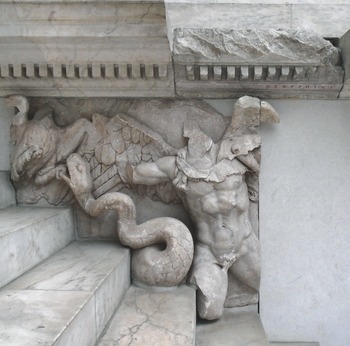
XV. Detail of southwest wing of the Pergamon Altar (c. 180–160 BCE), with signature of Theorrhetos on upper molding. Berlin.
Reiterations
1. The signing of sculpture followed no rules. Again, in no period and in no place was signing sculpture obligatory, and even when there is signing there are no discernible principles governing it (besides the obvious one that the sculptor signed, with an autograph or through a proxy, what he, and no one else, made).92 There is, in short, a randomness that rivals the inscrutable, erratic practices seen in other genres. There is no obvious reason why the Phrasikleia korē [Figs. 55, 56] should have been signed but not, so far as we know, the Anavyssos kouros [Fig. 2]. There is no obvious reason why Khairedemos’ funerary statue [Fig. 72], made by Phaidimos, should have been signed but not the Acropolis’ Moschophoros (which just might also be a work of Phaidimos and whose one-line dedication was evidently cut by the same hand that twice inscribed Phaidimos’ signature elsewhere).93 Richly inscribed works like the Mantiklos Apollo and the Nikandre korē suggest that the mere presence of lengthy texts of other kinds did not necessarily attract the writing of signatures. And it is just dumb luck that we happen to have a number of signatures by Praxiteles [Figs. 53, 54] and Lysippos [Fig. 57] but none at all by Polykleitos the Elder, Agorakritos (who is said to have hung signs with his own name on works of Pheidias), or Euphranor.
2. Signing had regional and chronological dimensions.94 Whether the sculptor signed or not had something to do with where he was from, where he worked, what he worked on, and when he worked. For one thing, Athenians in general just seem to have liked writing more than other Greeks – a graphomania also seen on their vases. For another, they signed some things others did not: in Archaic Greece signatures on funerary monuments occur, with a few exceptions, exclusively in Attica.95 Archaic Athenian sculptors also sign dedications, of course, but outside of Attica, almost all Archaic signatures appear on votives. East Greek sculptors tend to sign directly upon the bodies or garments of their statues [Fig. 59]; Athenians never do. Grave stelai are often signed in the 6th century [Figs. 63, 65], but not at all in the 4th, despite the large number of epitaphs and inscriptions identifying the depicted figures (perhaps sensitivities had changed, and it was no longer considered appropriate to inject the name of the sculptor between the mourner and the dead).96 Yet in the 4th century, far more Athenians (or, at least, sculptors who worked in Athens) sign their works than sculptors from any other place – 19 Athenians as opposed to four Rhodians, two Peloponnesians, one Parian, and so on.97 So, as in other genres (such as potting and vase-painting, where the bulk of signatures are Archaic and Athenian), practices sometimes changed from one period to another, and varied from place to place.
So, too, signatures may have become more common later in the history of Greek sculpture than they were earlier. There appears to be a rough correlation between the proliferation of private portrait statues in the Late Classical and Hellenistic periods (on Delos, for example, or in the Agora, or on the Acropolis) and the number of extant signatures.98 The impulse to sign seems especially powerful in the Hellenistic period, even in a number of genres besides sculpture.99 It is probably not coincidental that signed mosaics, as we have seen, do not appear before the late 4th century [Fig. 27], and that the impulse to sign is now detectable even in mass-produced “minor” arts. The terracotta lamps that Archaic and Classical Greeks used to light their way, and the terracotta figurines they dedicated, are in every case unsigned. The earliest signatures of Greek lamp-makers (such as Apollonides, Asklepiades, and Dionysios of Athens) and coroplasts (such as Agestratos, Hyperbolos, and Diphilos of Myrina or Menekrates of Priene) do not appear until the 2nd century BCE.100
3. Most extant sculptor signatures are proxies, not autographs. In the Archaic period, some sculptors signed at least some of their own work: this is undoubtedly true for Euthykartides, […]otos, [Poly]medes of Argos, Terpsikles of Miletos, Eudemos, and Geneleos of Samos – all datable around or earlier than 550 BCE – and it is probably true for such sculptors as Endoios, Philergos, Pythis, and Aristokles later on (that their signatures can on occasion differ in style from associated epitaphs or dedications is the strongest clue) [cf. Fig. 69]. But by the end of the 6th century – and then long afterward – most dedications, epitaphs, and signatures were inscribed by anonymous professional letterers who either were in the employ of the sculptors themselves (members of their ateliers, perhaps) or were freelancers hired by the client or patron.101 In other words, the majority of what we are used to calling “sculptor signatures” are statements of authorship carved by someone other than the sculptor himself: they are proxies. One mason is thought to have inscribed signatures for at least three different Archaic sculptors (Phaidimos, Aristion, and Aristokles), for example, and there are sculptors (Phaidimos, Aristion) known to have used at least two different letterers. So, too, the mason who inscribed the base of Acropolis Korē 681 with the dedication of Nearkhos and the signature of Antenor [Pl. X] evidently also inscribed the signature of Euthykles on a columnar base from the Acropolis, as well as public decrees, and so cannot have been Antenor himself.102 But if, from the late Archaic period onward, inscription was normally regarded as the province of the professional scribe, autographs are occasionally still found even in the Classical period: Euenor's signature on the base of Angelitos's Athena [Pl. XIII, Fig. 70], written in a different hand from the dedication, and the (lost) signature of Pheidias “below the feet” of the Zeus at Olympia (430s BCE) are, again, likely examples.
4. The decision to sign was usually not the sculptor's to make. An inscribed monument, as we have seen, typically names the dedicant (normally the person responsible for commissioning it), the god who is honored or the mortal who is commemorated by it, and, on occasion, the sculptor who executed it. In the hierarchy of dedicant, subject, and artist, the dedicant in almost every case occupies the highest, the artist the lowest, rung, which is why the dedicant's name typically begins an inscribed text and the sculptor's signature typically ends it.103 Even at the very start, on the base of Euthykartides’ kouros [Fig. 1], ANETHEKE (“dedicated”) comes before POIESAS (“having made”), indicating that Euthykartides himself considered his dedication of the statue more important than his carving of it. Dedication, after all, was the sacred act.
For the most part, then, the dedicator of a votive or funerary monument – the client, the one who hired the builder and sculptor and letterer (when they were different) – controlled not only the nature of the monument itself but also the content of whatever was written upon it. The form of the base, the kind of statue or relief that stood atop it, the presence or absence of a signature (as well as its size and location), were, in the end, up to him. The evidence suggests that in the history of Greek sculpture a strong majority of dedicants declined to solicit or approve the inscription of a signature. But some apparently believed that even a centimeter-high signature would add prestige to the monument, to their benefit. That is, a signature inscribed by a professional letterer rather than by the sculptor himself may not so much express the artist's pride in his own work or his own ego as the client's discernment and pride in having had the artist work for him.104 At all events, while some sculptors undoubtedly had more influence over the form of a monument than others – it is easy to imagine patrons consulting with Praxiteles or Lysippos, for example, rather than simply dictating to them, and any sculptor worth his salt would have had an interest in making sure his statue was properly installed – the major decisions (including whether to hire a letterer to engrave the sculptor's signature, and whom to hire) must ultimately have been made by the one who paid the bills.
5. Font size is not an infallible guide to artistic status. Most Archaic and High Classical signatures are written on the same scale (or virtually so) as the associated dedication, epigram, or epitaph [cf. Figs. 72, 74, 82]. In the Late Classical and Hellenistic periods, however, sculptor signatures are typically small, even minuscule, compared to the texts they accompany. And so the question is, did the status of the Greek sculptor diminish over time in proportion to the size of his signature? Is there a correlation between the size of the lettering and the importance of the sculptor who is named in the signature? The answer is: probably not. Those who would claim that the small size of Paionios's signature at Olympia [Pl. XIV] or Praxiteles’ on the Kleiokrateia base [Fig. 53] or Bryaxis’ on his tripod base [Fig. 85] reflects those sculptors’ marginal role in the installation of their monuments, or the low esteem in which they were generally held by their fellow Greeks, must still explain why the signatures are there at all: their very existence proves that the names of Paionios, Praxiteles, and Bryaxis were worth recording – and worth reading out loud (and presumably one did not read aloud little words more softly than big ones). The same logic would, in any case, lead to the conclusion that the relatively large size and centrality of signatures on many Archaic and Early Classical monuments [cf. Figs. 70, 73, 76, 79] reflect the prominence of the sculptor and his high status in the 6th and early 5th centuries (and that in turn would undercut the conventional wisdom that the Greek sculptor, like other disparaged artisans, was in every period a mere banausos). In a few cases, such as Philergos’ inordinately large signature (probably an autograph) on the Leanax base [Fig. 77] or Euphron's on his Acropolis monument (probably a proxy),105 font size would even suggest that the sculptor's name was more important than his subject's or his client's. This is a difficult conclusion to maintain, and so is any strong correlation between typography and status: it is unlikely that Philergos, in his day, was more important or esteemed than Praxiteles, in his.106



